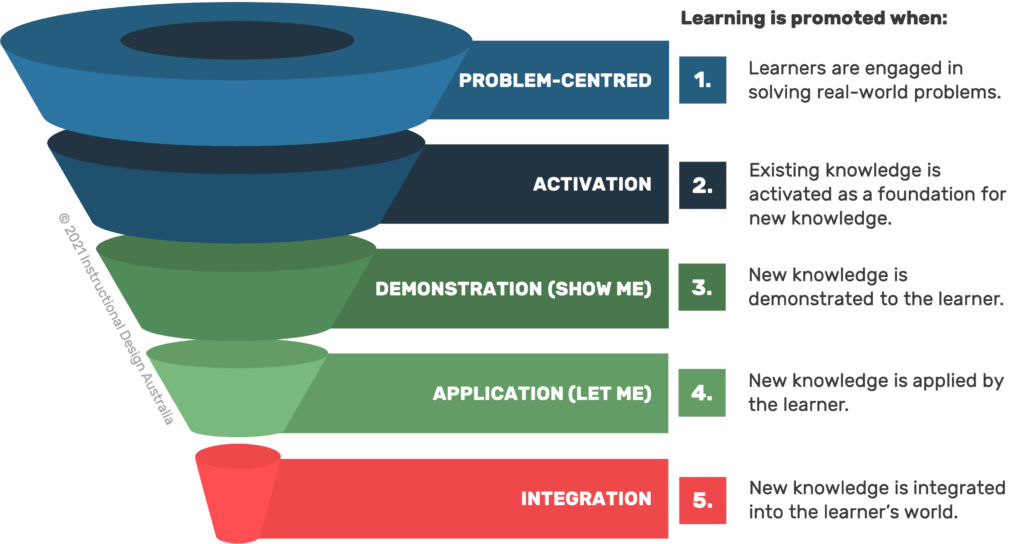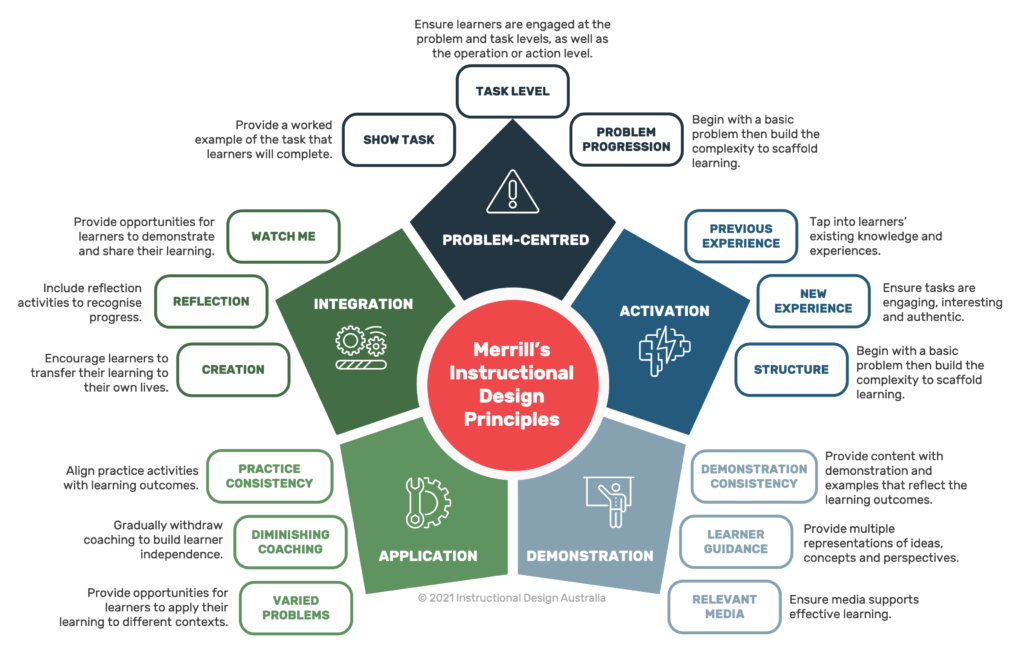How to Apply Merrill’s Instructional Design Principles
What Are Merrill’s Instructional Design Principles?
David Merrill, a renowned researcher of education, reviewed many learning design theories. His findings identified commonalities across instructional design theories. These shared beliefs formed the base of his own instructional design theory – Merrill’s first principles of instruction.
Merrill proposed learning is promoted when instruction:
- Is problem-centred.
- Activates existing knowledge.
- Includes demonstrations.
- Provides opportunities for application.
- Supports integration into the real world. [1]
Adapted from First principles of instructional design, 2002.
How To Apply Merrill’s Instructional Design Principles
Merrill broke the five principles down into further detail.
1. Learning is promoted when instruction is problem-centred.
Show Task: Provide a worked example of the task that learners will complete.
Task Level: Ensure learners are engaged at the problem and task levels, as well as the operation or action level.
Problem Progression: Begin with a basic problem then build the complexity to scaffold learning.
2. Learning is promoted when instruction activates existing knowledge.
Previous Experience: Tap into learners’ existing knowledge and experiences.
New Experience: Ensure tasks are engaging, interesting and authentic.
Structure: Begin with a basic problem then build the complexity to scaffold learning.
3. Learning is promoted when instruction includes demonstrations.
Demonstration Consistency: Provide content with demonstration and examples that reflect the learning outcomes.
Learner Guidance: Provide multiple representations of ideas, concepts and perspectives.
Relevant Media: Ensure media supports effective learning.
4. Learning is promoted when instruction provides opportunities for application.
Practice Consistency: Align practice activities with learning outcomes.
Diminishing Coaching: Gradually withdraw coaching to build learner independence.
Varied Problems: Provide opportunities for learners to apply their learning to different contexts
5. Learning is promoted when instruction supports integration into the real world.
Watch Me: Provide opportunities for learners to demonstrate and share their learning.
Reflection: Include reflection activities to recognise progress.
Creation: Encourage learners to transfer their learning to their own lives.
Infographic Summary of Merrill’s Instructional Design Principles
Adapted from First principles of instruction, 2002. [2], and First principles of instruction: A synthesis, 2007 [3].
Other Instructional Design Principles
Merrill’s First Principles have been aligned to many other principles of instructional design, including Clark and Mayer’s Principles for eLearning, Allen’s eLearning Principles and Minimalist Instruction [4].
Related Articles and Blogs
Click on the links below to learn more about instructional design.
- What is Instructional Design?
- Instructional Design Courses
- What Do Instructional Designers Do?
- Merrill’s Instructional Design Principles
- The 70:20:10 Learning Model
- Applying Problem Based Learning (PBL)
- How-To: Design For Online Courses
- What is the ADDIE Model of Instructional Design Anyway?!
Read more of our blog articles here.
References
[1][2] Merrill, M. D. (2002). First principles of instruction. Educational technology research and development, 50(3), 43-59.
[3] Merrill, M. D. (2007). First principles of instruction: A synthesis. Trends and issues in instructional design and technology, 2, 62-71.
[4] Merrill, M. D., Barclay, M., & van Schaak, A. (2008). Prescriptive principles for instructional design. Handbook of research on educational communications and technology, 3, 173-184.






